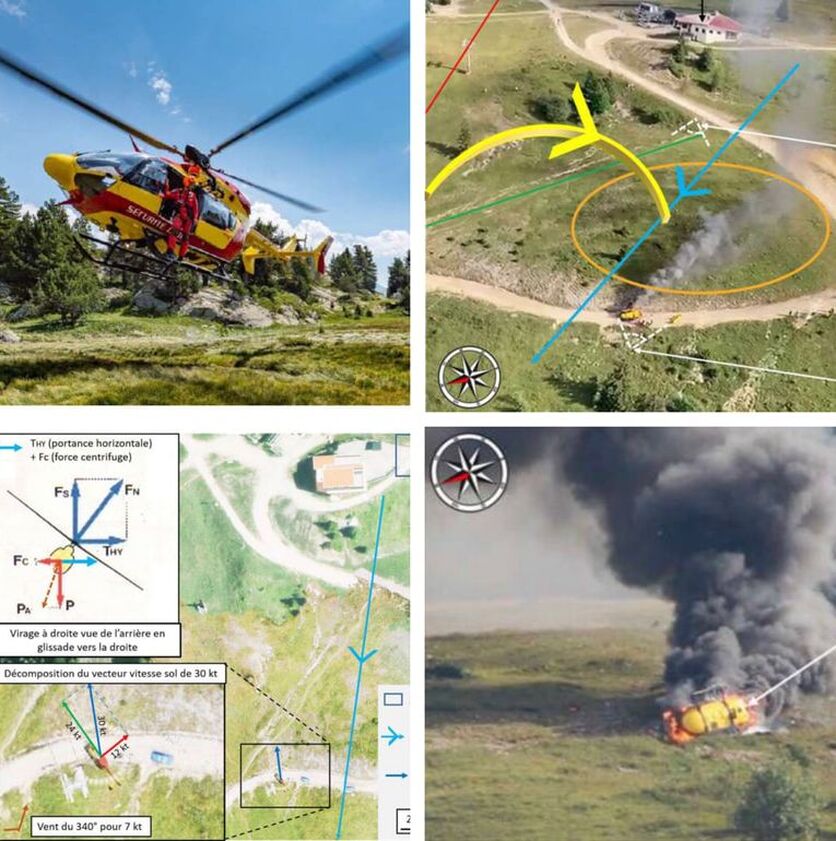On September 12, 2021, around 4:00 PM, the DRAGON 38 helicopter of the BH38 took off for a medical mountain rescue mission for a mountain biker in the ski resort of Villard-de-Lans, France.
Paragliders are present in this sector. DRAGON 38 began its reconnaissance of the area by activating its siren to free its sector of evolution. After locating the victim, the crew decided to land on a flat area located at the top of the slope about 100 meters from the victim.
The helicopter then flew over the landing area. DRAGON 38 began its set-up by moving slightly away towards the downhill slope. At the end of the turn to the right, still in the turn and at low speed, the pilot notices that his indicated airspeed is zero. He then tilted the machine more towards the slope offering him a clearance. The helicopter plummeted and hit the grassy slope. It then struck a rock head-on, causing the rear section of the helicopter to break off, roll several times and end up about 30 meters below on a road.
iwiation GmbH made a wind model and a three-dimensional reconstruction of the accident.
Research of the causes of the event:
The expert reports and the performance curves of the EC 145-C2 helicopter show that a disengagement maneuver was not necessary to allow the helicopter to continue a safe flight at the maneuver was not necessary to allow the helicopter to continue a safe evolution at the time this maneuver was when this maneuver was initiated. By leveling the helicopter, which had 29° of right bank, there was sufficient power available to maintain level flight and regain airspeed.
The pilot probably focuses all his attention on the landing zone, generating a change of attitude of the helicopter and a reduction of speed indicated without his knowledge. His sudden perception of this situation, which was not in accordance with his expectations, as the helicopter was approaching the slope with a tailwind, led him to disengage.
Paragliders are present in this sector. DRAGON 38 began its reconnaissance of the area by activating its siren to free its sector of evolution. After locating the victim, the crew decided to land on a flat area located at the top of the slope about 100 meters from the victim.
The helicopter then flew over the landing area. DRAGON 38 began its set-up by moving slightly away towards the downhill slope. At the end of the turn to the right, still in the turn and at low speed, the pilot notices that his indicated airspeed is zero. He then tilted the machine more towards the slope offering him a clearance. The helicopter plummeted and hit the grassy slope. It then struck a rock head-on, causing the rear section of the helicopter to break off, roll several times and end up about 30 meters below on a road.
iwiation GmbH made a wind model and a three-dimensional reconstruction of the accident.
Research of the causes of the event:
The expert reports and the performance curves of the EC 145-C2 helicopter show that a disengagement maneuver was not necessary to allow the helicopter to continue a safe flight at the maneuver was not necessary to allow the helicopter to continue a safe evolution at the time this maneuver was when this maneuver was initiated. By leveling the helicopter, which had 29° of right bank, there was sufficient power available to maintain level flight and regain airspeed.
The pilot probably focuses all his attention on the landing zone, generating a change of attitude of the helicopter and a reduction of speed indicated without his knowledge. His sudden perception of this situation, which was not in accordance with his expectations, as the helicopter was approaching the slope with a tailwind, led him to disengage.
| s-2021-18-a.pdf | |
| File Size: | 1540 kb |
| File Type: | |

